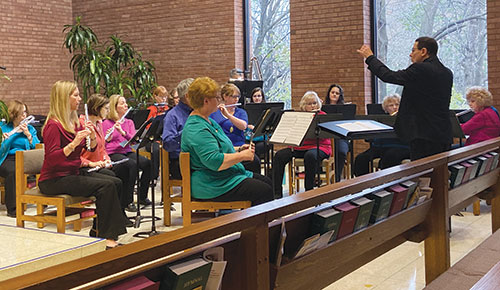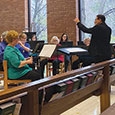Flute choirs play in a variety of settings that each come with different programming considerations. The easiest setting might be a program of background music for an event like a farmer’s market, reception, or cocktail party. In this situation the audience is occupied mixing with each other , and their attention is not solely directed towards the flute choir. Many flute choir directors make gig books for these occasions as well as for weddings and various holiday events. A traditional gig book includes 10 to 12 shorter compositions which provide about 50 minutes of material. After playing through them, the musicians take a short break and then repeat the set of compositions again. In performance, the playing order should alternate by tempo and key. Variety is the objective for this type of performance. In locations where the acoustics are not the best, pieces with block scoring or where a large number of people play rhythmically at the same time will sound the best to listeners. Solo passages with one on a part will simply be too soft to be heard.
Concerts at nursing homes, assisted living facilities, and hospitals can use the same gig books with the addition of special pieces. When I lived in Illinois, the community I was performing in had been settled by Germans. We often added German songs for performances of this type. This was music that had been popular when audience members were young. Many times, we noticed them singing along with the songs – often with tears in their eyes. A little research into who the residents are can help make your programming meaningful.

photo by Tim Day
Programming a Classical Concert
The format for a standard orchestral program has traditionally been: overture, concerto, intermission, symphony. Another idea, successfully implemented by Michael Tilson Thomas and the San Francisco Symphony, is to program something the audience knows well, something they kind of know, and something totally new. Some organizations arrange a program around works by a single composer. This might be a performance of the Bach Brandenburg Concertos or an concert with an overture, concerto, and symphony by Beethoven, Dvo˘rák, Brahms, or Mozart. Other programs are based on a theme such as Romeo and Juliet (Tchaikovsky and Prokofiev) or a holiday.
Flute Choir Programming
Programming a classical flute choir concert is more of a challenge because the ensemble is relatively new and does not have an established core repertoire. When flute choirs began to become popular in the late 1960s, James Hooks’ Six Trios, Joseph Bodin de Boismortier’s Six Concertos for five flutes, Fredrich Kuhlau’s Grand Quartet in E Minor, Op. 103, and pieces from the Rubank Flute Quartet Books were featured on many programs with the addition of a few shorter programmatic compositions.
When developing a program, start by considering elements such as the playing ability of the group, the number of players it takes to cover all of the parts, and the type of concert it is intended to be. Additionally think about the styles of the compositions, the key relationship from one piece to the next, the length of each piece (varying the length of each composition makes for more engaging programming), and variety of instrumentation. These variables make programming a complicated job if it is done well.
Since a flute choir is a consort – meaning that all of the instruments produce the sound in the same way, it is easy for the sound to become stale or boring for the audience. Mixing in compositions requiring other instruments (piano, harp, voice, percussion etc.) changes the timbre and makes the aural experience more interesting. Also, to keep listeners attentive, plan a concert of about one hour including the time it takes for performers to switch instruments and move to another seat.
Core Composition
Start building a program by selecting a core composition. This is a longer work, perhaps 15 minutes or more, that is very well-written. Good choices include compositions like Petite Suite by Claude Debussy/Shaul Ben-Meir, Simple Symphony by Benjamin Britten/Robert Rainford, St. Paul’s Suite by Gustav Holst/Lana Behrens, or Suite on Old English Folk Songs by John Rutter/Robert Rainford among many others. This is the anchor piece for the concert from which you will build the program.
Select an Opener
Traditionally a concert begins with a fanfare or an overture. The purpose of an overture is to get the audience actively listening and tuned into the concert. The overture may begin with a slow introduction and then move into a quick tempo either in sonata or rondo form. There are many original pieces and transcriptions available to fit the bill. One of my favorites is Ralph Vaughan Williams’ The Wasps.
For added interest in a concert, consider playing the overture or fanfare with players spread around the concert hall. One of the Boismortier Five Concertos is especially interesting to perform in this arrangement because of the antiphonal effects written in the music. It is exciting for listeners to hear music coming from all sides of the venue. It is also even more exciting when the ensemble plays the dynamics so that they vary from side to side and front to back.
The opening work should complement or contrast with the core composition; there should be a connection between them. It might be that both are by the same composer or programmatic topic or have the same or contrasting style period.
Select a Closer
Think of the closer as an encore to the concert. Marches are especially good for this position or perhaps one of the clever compositions by Nicole Chamberlain. Since I live in a city that has a prominent railroad, both performers and audience members recently delighted in her Railroaded composition. Performing this piece also offered the opportunity to demonstrate extended techniques.
Featuring a Soloist
There are many excellent flutists playing in flute choirs today. Featuring one as a soloist offers the chance for the person to be heard, and also is an excellent vehicle for teaching the group how to accompany. Our flute choir has featured members in the Vivaldi’s “Goldfinch” Concerto, Telemann’s Suite in a Minor, Mozart’s Concertos in G and D, John Rutter’s Suite Antique, Bach’s Concerto for Flute (Violin) in A Minor, Faure’s Fantaisie, and Cimarosa’s Concerto in G for two flutes.
Playing accompaniment is a fantastic tool for improving ensemble skills such as playing softly, with the same note lengths, with reduced or no vibrato, and with the appropriate stylist timbre of early music. Usually the accompaniment parts are relatively easy, so there is a lot of opportunity for players to tune into the more subtle elements of chamber music playing.
Filling In
Frederick Fennell, the legendary Eastman Wind Ensemble conductor, was fond of programming new music as well as classics in the repertoire. Most of his programs also had one folk song that everyone knew well. There are excellent arrangements for flute choir of folk songs such as Kelly Via’s By Kells Waters and Amy Rice Young’s Scarborough Fair among many others.
Programmatic compositions are also another genre to use to complete a concert program. A programmatic work is one that tells a story, relates to a geographical location, or communicates an idea. Generally, one programmatic composition per concert is enough.
Difficulty
When publishing flute choir music, music publishers include a grade level for the composition. The grade level is based on time signatures, rhythms, tonality, tempo, range or tessitura, and scoring choices (block scoring/independence of parts). The grading system is helpful to find pieces written at the appropriate level. Since most flute choirs have a planned schedule of concerts, there is never enough time to rehearse everything as thoroughly as the conductor and players would like. Selecting a program with too many difficult compositions ensures that there will always be under-rehearsed passages on the program. Selecting compositions from various levels will improve the performance level of the entire program. This said, be aware that simple pieces (grades 2 and 3) will show off the weaknesses of the group because everything is exposed. These issues could be attacking the beginnings of phrases at the same time, releasing the ends of phrases together, blending of the sound, intonation, shaping melodies, and playing simple rhythms in the exact time. However, playing these easier compositions offers a valuable opportunity to fix these problems and improve the ensemble playing level of the group.
Several flute choir composers have written excellent lower to middle grade compositions with artistic success. The flute choir pieces by Keith Amos feature block scoring and are excellent for ensembles with less experience rhythmically. Phyllis Avidan Louke also has written or arranged a variety of pieces using this technique. Her catalog lists Flexible Flute Ensemble pieces in a variety of themes including Christmas and Hanukkah music, Irish music, Jewish music, hymns, classical and patriotic songs. Ricky Lombardo wrote Expandable Flute Choir compositions for piccolo and 3 C flutes or 4 flutes. Other instruments may be added expanding the ensemble. With this expansion he adds to the harmonic structure and sometimes offers new countermelodies to the original four parts. There are also bass and drum parts available. The Louke and Lombardo works are especially good for programming when you are not sure exactly how many players are available to play in the concert.
Send Your Programs
Since programming is an ongoing concern for flute choir directors, send your programs as a pdf to editor@flutetalkmagazine.com to share ideas with others.
Some Sample Programs:
Rose City Flute Choir, Portland, OR
2016 Spring Program
Fox Valley Flute Choir, Appleton, WI






